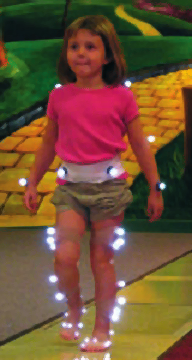
Gait Analysis Laboratory Homepage
Difficulties with walking in children can occur with Cerebral Palsy, Myelo-menigocele, and other neuromuscular conditions. Treatments for gait disfunction can include physical and occupational therapy, orthotic management, drug therapies, and surgical intervention. Historically, these treatments have been prescribed based simply on visual observations of the child's walking.
 The Gait Analysis Laboratory at the duPont Hospital for Children was
created in 1993 to provide the medical community with state-of-the art, computer
assisted motion analysis of the complex gait cycle. Detailed information can
be gathered about the movement of various joints, the patterns of muscle
contractions, the associated forces affecting the limbs and the energy
demands of altered gait.
The Gait Analysis Laboratory at the duPont Hospital for Children was
created in 1993 to provide the medical community with state-of-the art, computer
assisted motion analysis of the complex gait cycle. Detailed information can
be gathered about the movement of various joints, the patterns of muscle
contractions, the associated forces affecting the limbs and the energy
demands of altered gait.
Several computers are used to collect three-dimensional video data and electromyographic data, perform kinematic and kinetic calculations, and process that information into a format for interpretation. Adhesive electrodes measure muscle activity and special reflective markers track joint movement. Foot pressure measurement and metabolic analysis are also available to enhance the assesment and provide a complete picture of the child's gait. This dynamic information, combined with a physical examination, visual observation, and the development history (provided by the family and medical record), gives greater insight into the causes of gait abnormalities.
There are several testing procedures that may be included in the gait analysis. The refering physician, orthopedic surgeon, physical therapists, and other members of the team consult to decide which tests are appropriate for each child. Many factors are considered in this decision including age, height, and weight, diagnosis, level of functional independence, and ability to cooperate for structured testing.






